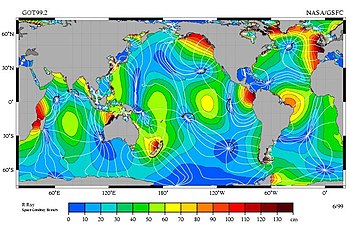(expanded info on this at new blog Nov 2015)
As is sometimes the case,the Wikipedia article on the Tides might not be accurate.
In simple terms, regarding how the tide works, if you are standing on the beach watching it, the tide is a giant wave. A rotating Kelvin wave to be precise.
Seriously. The tide is a giant wave passing you by. When the crest comes down (or up) the coast, the water rises, at the peak of the wave, it is high tide. As the wave goes on by, the water goes down, at the trough of the wave, it is low tide. It is a giant circular wave that rotate around a point, and the high tide you see is the same crest of the wave each time. There is only one wave that makes both tides each day.
If you are standing on one of the rare places that has only one high tide, it is still the same thing, a giant wave, circling. Some places have a mixed tide, where both kinds of tides interact with each other, so two (or more) giant waves are causing the tide.
Here is the amplitude of the tide from just the moon, if it rotated exactly around the equator, and didn't change distance.

Here is an animation I made that shows the waves in motion, along with the moon moving. The large bar is full moon, the small bar is the other side of the planet, the water can either be high is light color, or dark, it doesn't matter. It is just a model of what the oceans look like.

The water moving animation I "borrowed" from Steve Dutch and his
website
I edited the original, just doubled it and added the bars. I did not create the original water animation. Steve would probably be pissed if he knew.
Extensive satellite measurements of the oceans show that the ocean actually does behave a lot like that model, but not as clean and easy to see. But the tides actually are giant circular waves. The ocean does not follow the moon around the earth like many people want to believe. The 'two bulges' theory is not an accurate representation of how the oceanic tides work.
See the Dynamic Theory of Tides, and if that isn't explaining why there are no twin bulges, go here
edited Jan 1 2016
As is sometimes the case,the Wikipedia article on the Tides might not be accurate.
In simple terms, regarding how the tide works, if you are standing on the beach watching it, the tide is a giant wave. A rotating Kelvin wave to be precise.
Seriously. The tide is a giant wave passing you by. When the crest comes down (or up) the coast, the water rises, at the peak of the wave, it is high tide. As the wave goes on by, the water goes down, at the trough of the wave, it is low tide. It is a giant circular wave that rotate around a point, and the high tide you see is the same crest of the wave each time. There is only one wave that makes both tides each day.
If you are standing on one of the rare places that has only one high tide, it is still the same thing, a giant wave, circling. Some places have a mixed tide, where both kinds of tides interact with each other, so two (or more) giant waves are causing the tide.
Here is the amplitude of the tide from just the moon, if it rotated exactly around the equator, and didn't change distance.

Here is an animation I made that shows the waves in motion, along with the moon moving. The large bar is full moon, the small bar is the other side of the planet, the water can either be high is light color, or dark, it doesn't matter. It is just a model of what the oceans look like.

The water moving animation I "borrowed" from Steve Dutch and his
website
I edited the original, just doubled it and added the bars. I did not create the original water animation. Steve would probably be pissed if he knew.
Extensive satellite measurements of the oceans show that the ocean actually does behave a lot like that model, but not as clean and easy to see. But the tides actually are giant circular waves. The ocean does not follow the moon around the earth like many people want to believe. The 'two bulges' theory is not an accurate representation of how the oceanic tides work.
See the Dynamic Theory of Tides, and if that isn't explaining why there are no twin bulges, go here
edited Jan 1 2016
No comments:
Post a Comment